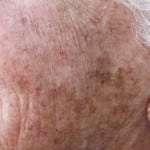 Dermatologists and skin care experts often use the term “Sun Damage”, but what does it truly mean? Well… It takes a little bit of explaining to truly understand the full scope of sun damage. Sun Damage represents a spectrum changes observed on the skin that directly results from exposure and overexposure to sun and UV light. The effects of this exposure range anywhere from skin darkening, freckling, to full blown skin cancer. The sun is not the only cause for this type of damage. Indoor tanning has become a trend and hobby in recent decades and has also been implicated as a major source of damage to the skin.
Dermatologists and skin care experts often use the term “Sun Damage”, but what does it truly mean? Well… It takes a little bit of explaining to truly understand the full scope of sun damage. Sun Damage represents a spectrum changes observed on the skin that directly results from exposure and overexposure to sun and UV light. The effects of this exposure range anywhere from skin darkening, freckling, to full blown skin cancer. The sun is not the only cause for this type of damage. Indoor tanning has become a trend and hobby in recent decades and has also been implicated as a major source of damage to the skin.
Photo-aging is a term used to describe an number of changes seen on the skin that can be directly attributed to UV exposure. “Ninety percent of the changes we call ‘aging’ on the skin can actually be related to sun exposure,” says Dr. Miriam Hanson, board certified dermatologist and cosmetic skin care expert in Austin, Texas. With photo-aging, patients notice a loss in skin elasticity, as well as darkening and a thickened leather-like texture to the skin. Other common characteristics of photo-aging include wrinkles, broken blood vessels, sallow and sagging skin.
Age Spots, Liver Spots, and Lentigos are used to describe dark spots that appear on the skin after repeated exposure from the sun. “These spots can sometimes mimic cancerous lesions and cause significant concern,” notes Dr. Adam Mamelak, a board-certified Dermatologist and Mohs Micrographic Surgeon in Austin. These pigmented marks appear on the  areas that come in direct contact with the sun and can be minimized with chemical peels or Intense Pulsed Light (IPL) treatments.
areas that come in direct contact with the sun and can be minimized with chemical peels or Intense Pulsed Light (IPL) treatments.
Poikiloderma (Poikiloderma of Civatte) is a reddish-brown discoloration of the neck that is acquired through chronic sun exposure. “In addition to the change in color, telangictasias, or dilated and broken blood vessels, can also be observed,” says Dr. Mamelak. The effects of this are mainly cosmetic, and these skin changes respond very well to laser treatments.
Solar Elastosis describes damage to the elastic fibers in the skin. Yellowing of the affected areas can be noted, as well as thickening and furrowing of the skin. “The damage done with Solar Elastosis is quite extensive and usually results in the need for dermal fillers or significant resrfacing for correction,” says Dr. Hanson. Micro-needling is another treatment that can assist in rebuilding and restoring the skin.
Favre–Racouchot Syndrome is the widening of the comodones and sebaceous glands, typically on the face. This grouping of exacerbated blackheads and whiteheads typically occurs around the eyes, but are possible other areas of the face and body. Treatment for this condition includes the use of topical creams and can be greatly improved with a steam and extraction session.
Actinic Keratosis (AKs) are described as a grouping of scaly or rough patches of skin that are caused by sun exposure, often found on the face, scalp, forearms and hands. These can vary in color from tan, pink to red, but are more often felt as rough spots and patches in sun exposed areas. “Although this can often be misconstrued as a skin irritation or eczema, these spots are actually considered pre-cancerous and should be treated seriously,” says Dr. Mamelak. Cryotherapy, photodynamic therapy as well as a number of topical treatments are available to remove these lesions from the skin.
Skin Cancer. Among the many skin changes and conditions that can arise from exposure to the sun, skin cancers like Melanoma, Basal Cell Carcinoma, and Squamous Cell Carcinoma are too often observed. Considered an ‘end stage’ of the sun damage process, these cancers vary in form and severity. They can also potentially be prevented by taking the proper precautions during outdoor activities, road-trips, but also while running errands and during day-to-day activities. Simple changes in our daily routine can drastically change the amount of exposure we get from the sun. Remember: Apply sunscreen, reapply sunscreen every couple of hours, and wear sun-protective clothing when possible!
Contact Us
Looking for ways to prevent or correct sun damage? Contact us today to set up your consultation!
Join Us
